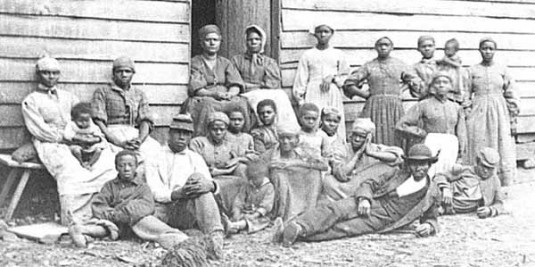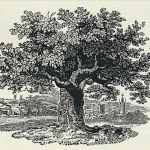In his diary, Benjamin Ellicott made several references to his father-in-law, Elisha Warford. Warford is a legendary figure in the history of the Locktown-Croton vicinity, so it seems appropriate to publish Mr. Bush’s recollections of the man. He was a controversial figure, extremely wealthy, and extremely litigious. He never hesitated to take his debtors to court, as the papers in the Warford Collection at the Hunterdon County Historical Society will attest. Warford was a difficult personality that Mr. Bush managed to write about without casting aspersions. But then Egbert T. Bush was always a gentleman. As usual, I will take the liberty of making comments and annotations.
Historians Revisited
Slavery in Hunterdon

In the most recent issue of the Hunterdon Historical Newsletter, Lois Crane Williamson wrote an article titled “The Last Slave in Franklin Township.” It shows that slaves were still living in Hunterdon County long after the Gradual Emancipation Act of 1804 was signed. The last advertisement for a runaway slave to appear in the Hunterdon Gazette was published on February 14, 1838:
Lime and Trees and Other Things
First Trip to Delaware River Kilns an Experience for a Boy
Spoke Making a Lost Trade
by Egbert T. Bush, Stockton, N. J.
published in the Hunterdon Co. Democrat, April 21, 1932
 In recognition of the belated arrival of spring, I offer Mr. Bush’s tale of how farmers got lime for their fields in the mid 19th-century. And among those “Other Things,” Mr. Bush describes the business of spoke making.
In recognition of the belated arrival of spring, I offer Mr. Bush’s tale of how farmers got lime for their fields in the mid 19th-century. And among those “Other Things,” Mr. Bush describes the business of spoke making.
As our forests were cut off and the stumps rotted away, the land was found to be or soon to become more or less sour. The sorrels began to grow plentifully, especially the tall, reddish brown one that we called “horse sorrel.” That was later known as a sure indication that the land needed lime, tho in the earlier stages little was known about sour land or the indications, or even about lime as a sweetener. Such knowledge, like almost every other kind, grew gradually with experience and observation, until science took hold of such matters and showed us to be sometimes on the right track without knowing exactly why.
Asa Romine and Sarah Fulper
Postscript to “Asa Romine’s Beloved Farm“
Some time ago I got a copy of an article in the Democrat-Advertiser of 1902. Actually, copies of several articles, but I neglected to file them in any useful way. Today, I stumbled across this particular article and immediately regretted not having it at hand when writing about Asa and Sarah Romine. It is a celebration of their long married life, probably written by Jonathan M. Hoppock. Here it is:
Some Controversial Baptist Ministers
My original intention was to publish an article by Jonathan M. Hoppock on the history of the Baptist Church in Locktown. And that is what I will do here, but after reading his article, I discovered that some of the ministers he listed had troubled careers, and that, of course, makes them interesting. But first, here is Mr. Hoppock’s history of the Church.
How Locktown Got Its Name
Back in February, I published an article on the cemetery connected with the Locktown Baptist church. Previously I have written about the Baptist congregation here as well as the Locktown Christian Church and its Cemetery. It seems appropriate now to include Mr. Bush’s own history of this neighborhood, which was published in the Hunterdon Democrat, on May 22, 1930. Along with the churches, Mr. Bush discusses the school house, the distillery and the Locktown Hotel, which began its life as a humble tavern, and also some of the old families, like the Chamberlins, Heaths, Lairs, Rittenhouses, Smiths and Suttons. Photographs in this article were provided by Paul Kurzenberger.
The Supreme School
Having published Mr. Bush’s article, “The ‘Oregon’ and Other Schools,” and then a follow-up on Duck’s Flat, I thought I was done with this neighborhood for now. But I recently found another article by Mr. Bush continuing the story of Ducks’ Flat school. This article has allowed me to identify the mystery school I referred to previously, located down the road from the Ducks’ Flat school that Mr. Bush was familiar with. But I’ll wait until Mr. Bush has concluded before explaining.
Articles by J. M. Hoppock
Jonathan M. Hoppock, known as ‘Jonty,’ was born Sep. 20, 1838 to Henry J. Hoppock and Lydia Wolverton. The family lived on a farm near Sand Brook in Delaware Township. Hoppock became a school teacher and developed a love of local history. Late in his life, the Democrat-Advertiser published articles he submitted about the places he knew best, nearly all of them in Delaware Township.
Rev. Joshua Primer
by J. M. Hoppock, March 24, 1904
published in the Democrat-Advertiser
This is an obituary, for Rev. Joshua Primmer, who died on March 18, 1904. I wrote about Rev. Primmer in May 2014, in my article “From Primmer to Pauch.” At that time, I had forgotten my intention to eventually publish all of J. M. Hoppock’s articles with annotations. So today I am making up for that oversight. If you check the very end of the page “Index of Articles,” you will see a complete list of those articles, separated into those that have been published here, and those as yet unpublished.
It is odd that Mr. Hoppock consistently wrote the name as “Primer.” I wonder if he pronounced the name that way. Apparently that is the way his grandfather wrote it, but it is not the way Rev. Primmer wrote it.
Hunting for a Cemetery
Three Great Hunterdon Co. Historians Try to Find the Opdycke Cemetery
Over five years ago, I published an article about the Opdycke Cemetery in the Delaware Township Post. It has now been revised as “Opdycke Cemetery Revisited.” More recently, I came across some letters exchanged by Egbert T. Bush and Hiram E. Deats regarding their attempts to find this burying ground and to identify who was buried there. These letters can be found in the Egbert T. Bush Papers at the Hunterdon County Historical Society.